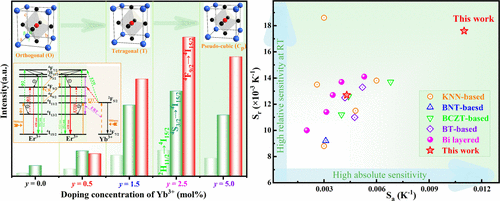当前位置:
X-MOL 学术
›
ACS Appl. Electron. Mater.
›
论文详情
Our official English website, www.x-mol.net, welcomes your
feedback! (Note: you will need to create a separate account there.)
Simultaneous Yb3+-Induced Phase Transition and Sensitized Luminescence in Er3+-Doped KNN-Based Lead-Free Ceramics for Optical Thermometry
ACS Applied Electronic Materials ( IF 4.3 ) Pub Date : 2020-08-23 , DOI: 10.1021/acsaelm.0c00628 Yan Zhao 1 , Xusheng Wang 1 , Ying Zhang 2 , Yanxia Li 1 , Xi Yao 1
ACS Applied Electronic Materials ( IF 4.3 ) Pub Date : 2020-08-23 , DOI: 10.1021/acsaelm.0c00628 Yan Zhao 1 , Xusheng Wang 1 , Ying Zhang 2 , Yanxia Li 1 , Xi Yao 1
Affiliation

|
Environment-friendly potassium sodium niobate-based ferroelectrics have been widely and deeply studied for their electrical properties, but there remains much potential for applications in other fields, one of which is in optical temperature sensing. Herein, a host (K,Na)Li0.04NbO3:0.5 mol% Er material with an orthogonal–tetragonal phase transition was constructed by Li+ regulation and then increased Yb2O3 codoping used to promote the occurrence of orthogonal to tetragonal and tetragonal to pseudocubic phase transitions. Interestingly, codoping with Yb2O3 as a sensitizer and phase structural changes regulated the resulting materials’ luminescent characteristics and greatly enhanced luminescence intensity and temperature sensing properties, compared with those of merely Er3+-doped samples. In addition, strong green and red light emissions were related to the large absorption cross-section of Yb3+ near 980 nm, which transferred more energy to Er3+. In particular, significantly enhanced red light, or red shift, was associated with energy back transfer at high Yb3+ concentrations. Furthermore, the optimal ceramic was (K, Na)Li0.04NbO3:0.5 mol % Er/2.5 mol % Yb (KNL0.04N:0.5 Er/2.5 Yb), and its maximum absolute and relative sensitivity of 0.0112 and 0.0173 K–1, respectively, which were higher than those of other reports. These results showed that KNL0.04N:0.5Er/2.5Yb lead-free ceramic possessed the potential to be an excellent optical temperature sensor with high intensity and sensitivity.
中文翻译:

Er 3+掺杂的KNN基无铅陶瓷中同时Yb 3+诱导的相变和敏化发光用于光学测温
环保型铌酸钾钠基铁电材料的电性能已得到广泛而深入的研究,但在其他领域仍具有很大的应用潜力,其中之一是在光学温度感测中。本文中,通过Li +调控构建了具有正交-四方相变的主体(K,Na)Li 0.04 NbO 3:0.5 mol%Er材料,然后通过增加Yb 2 O 3共掺杂来促进正交于四方和四方相的发生。四方到伪三次相变。有趣的是,与Yb 2 O 3共掺杂与仅掺Er 3+的样品相比,作为敏化剂和相结构的变化调节了所得材料的发光特性,并大大增强了发光强度和温度感测性能。此外,强烈的绿色和红色发光与980 nm附近Yb 3+的大吸收截面有关,这将更多的能量转移到Er 3+上。特别是,在高Yb 3+浓度下,显着增强的红光或红移与能量回传有关。此外,最佳陶瓷为(K,Na)Li 0.04 NbO 3:0.5 mol%Er / 2.5 mol%Yb(KNL0.04N:0.5 Er / 2.5 Yb),其最大绝对和相对灵敏度分别为0.0112和0.0173 K –1,高于其他报道。这些结果表明,KNL0.04N:0.5Er / 2.5Yb无铅陶瓷具有成为具有高强度和灵敏度的出色光学温度传感器的潜力。
更新日期:2020-09-22
中文翻译:

Er 3+掺杂的KNN基无铅陶瓷中同时Yb 3+诱导的相变和敏化发光用于光学测温
环保型铌酸钾钠基铁电材料的电性能已得到广泛而深入的研究,但在其他领域仍具有很大的应用潜力,其中之一是在光学温度感测中。本文中,通过Li +调控构建了具有正交-四方相变的主体(K,Na)Li 0.04 NbO 3:0.5 mol%Er材料,然后通过增加Yb 2 O 3共掺杂来促进正交于四方和四方相的发生。四方到伪三次相变。有趣的是,与Yb 2 O 3共掺杂与仅掺Er 3+的样品相比,作为敏化剂和相结构的变化调节了所得材料的发光特性,并大大增强了发光强度和温度感测性能。此外,强烈的绿色和红色发光与980 nm附近Yb 3+的大吸收截面有关,这将更多的能量转移到Er 3+上。特别是,在高Yb 3+浓度下,显着增强的红光或红移与能量回传有关。此外,最佳陶瓷为(K,Na)Li 0.04 NbO 3:0.5 mol%Er / 2.5 mol%Yb(KNL0.04N:0.5 Er / 2.5 Yb),其最大绝对和相对灵敏度分别为0.0112和0.0173 K –1,高于其他报道。这些结果表明,KNL0.04N:0.5Er / 2.5Yb无铅陶瓷具有成为具有高强度和灵敏度的出色光学温度传感器的潜力。











































 京公网安备 11010802027423号
京公网安备 11010802027423号